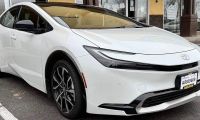This doesn’t match my understanding of how the hybrid propulsion works in the Kia Sorento PHEV, but what do I know? I am only making this statement with minimal real world testing. What I understand is: Sport mode slowly recharges the hybrid battery of the Sorento PHEV by capturing additional energy from the gas engine. The standard hybrid (HEV) mode does not do this; it just maintains the current level of charge (or if the battery has been discharged to about 20% or less, it may recharge it to that level). Sport mode revs at a higher speed or rate in order to create excess power that gets converted to electricity and stored in the drive battery (if the drive battery isn’t already fully charged). Sport mode also “unlocks” the full capability of the Sorento PHEV’s powertrain for a more responsive driving experience, but it always uses more gasoline in order to slowly charge the battery. Or so I believe.
Note, there are legitimate reasons one may want to charge the drive battery: to store extra or reserve power before going up a steep mountain pass with a heavy load (if you didn’t have enough charge remaining in the battery already), or if you live in a place with “green zones” that charge extra to those driving through on gasoline, instead of battery power. But otherwise, you're just wasting gas by using the Sport mode. Maybe that’s your thing, and you bought a PHEV thinking it’s all about the torque, dude . Given that some manufactures made PHEVs specifically to enhance performance (by the power of petrol! And a few lithium ion cells, too!), we should probably forgive anyone for thinking this.
But again, I’m not an engineer and I didn’t work on the team that built this rig, so how can I be so sure it isn’t more efficient to use Sport mode? To test whether I’m right about how Kia’s system works, I am performing the following test: I will drive solo in my Sorento PHEV on a familiar test loop that’s over 20 miles long and about 60% freeway or 40+ mph two lane side roads (around 13 miles total), and 40% 35 mph or less (about 8 miles total). I will make the first loop through the test as follows: Starting with a battery that has 12 miles of estimated range remaining (which is at its most efficient on neighborhood speeds and flat or downhill roads). On both loops I will first drive in EV mode until I merge onto the freeway (a little less than a mile from my house). I will try to drive no more than about 5 miles per hour over the speed limit for the entire route though I may drive slower or faster than that briefly, depending on traffic. The second loop, I will repeat the same conditions and maneuvers, however instead of switching to Sport mode, I will switch to the standard HEV mode at the same point and switch back into EV mode at the same point too. Doing it in this order should make sure that I have surplus charge to support running in EV mode for both loops and it should also help differentiate whether the Sport mode is more fuel efficient than the standard HEV mode. What do you think the outcome will be?
The results didn’t surprise me in the slightest. In Sport mode, I achieved a blended mpg rating of 34.1 on the approximately 40 min drive. The second time through, using HEV mode instead, I got a mpg rating of 63.3. It wasn’t even close folks! I’ll point out that the second drive did take 5 mins longer due to increased traffic in some parts of the drive, and was a few degrees warmer (high of 83 instead of 80), but since I wasn’t using the air conditioning, drove in the same fashion both times, the margin of error is less than a few mpg, at best.
This is only one simple test. Maybe there is some scenario out there I haven’t considered that would actually result in closer, or better, fuel economy results using Sport mode. If anyone can think of one, by all means, share it in the comments below because I would love to prove/disprove it because it is fun to learn new things (I promise!).
Ultimately it doesn’t surprise me that some people think using the gasoline engine to charge their battery winds up being more efficient. Plug-in hybrid technology is a little bit… convoluted. Plus, many people don’t quite understand how electric motors and batteries work, nor the electrical grid, nevermind their internal combustion engines.
Do you disagree with anything I’ve said? Do you have proof to the contrary? Are you positive that one can get better fuel economy by using gasoline to add charge to your hybrid battery?
Image by Justin Hart.
Justin Hart has owned and driven electric vehicles for over 14 years, including a first generation Nissan LEAF, second generation Chevy Volt, Tesla Model 3, an electric bicycle and most recently a Kia Sorento PHEV. He is also an avid SUP rider, poet, photographer and wine lover. He enjoys taking long EV and PHEV road trips to beautiful and serene places with the people he loves. Follow Justin on Twitter for daily KIA EV news coverage.













Comments
I own the PHEV model and the
Permalink
I own the PHEV model and the only scenario I’ve found where it is more efficient to run for awhile in Sport mode is if you’re coming into an area where there will be a considerable amount of “sitting” in stopped traffic. If the battery is low it helps to get it up to an amount that will allow you to not run the engine. I’ve found it only takes about 1-2 miles of battery capability to run the air conditioner for an hour standing still. Otherwise, sport mode is just for fun.
That makes sense! I suppose
Permalink
In reply to I own the PHEV model and the by Edward Staszko (not verified)
That makes sense! I suppose you are running the gas engine at a higher RPM though to regain that mile or two. Now you’re making me want to test the difference between running in Sport mode for say 4 miles or so vs. sitting idling in traffic for x amount of time (to run the AC, which runs off the hybrid battery). It might be hard to test that though… but I’ll consider it a challenge!
It’s more efficient to use…
Permalink
It’s more efficient to use gasoline when you’re at highway speeds. When driving under 45 miles per hour, use the EV mode. Over 45 mph, switch to the gas motor (HEV + Sport mode). Adding the sport mode will recharge your battery a little and save it for use when driving around town in EV mode.